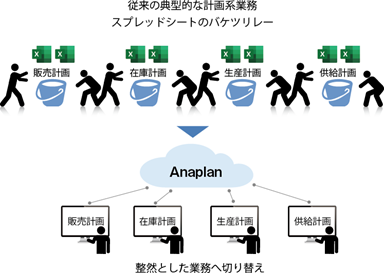While NOK has been focusing on the seal business since its founding, the company also provides a wide variety of original products for a variety of fields, including automobiles, electronic devices, and industrial equipment. In order to strengthen its business amidst rapid change and increasing uncertainty, the company embarked on a digital transformation (DX) of its sales planning operations and introduced the cloud-based planning platform "Anaplan" with the support of Business Engineering (B-EN-G). This has resulted in a significant reduction in the number of man-hours required for sales planning operations and an increase in speed.
Implemented Products/Solutions
Anaplan is a cloud-based solution that enables organizations to shift from inter-organizational coordination using spreadsheets to more systematic planning processes. It centralizes data management based on common worksheets and establishes standard processes. It also features dashboards and drill-down functions that speed up decision-making.

Reason for introduction
The COVID-19 pandemic has made the need for digital sales planning even more apparent
Previously, NOK used a bottom-up, cumulative approach to creating sales plans for its annual management plans. Specifically, sales representatives at each branch office (hereafter referred to as "branch sales") interviewed client companies, incorporated the results of those interviews into sales plans, and entered the plan data into a spreadsheet. This data was then compiled to create a company-wide sales plan.
This method had the advantage of allowing for fairly accurate planning. However, it also had the problem of being inefficient due to the frequent "bucket brigade" of spreadsheet files, and placing a heavy workload on branch sales. Nishino Hirotaka, assistant manager of the ERP Development Department, Ceiling Solutions Platform Development Office, ERP Section 2, explains the problem as follows:

Mr. Hirotaka Nishino, Assistant Chief of ERP Section 2, ERP Maintenance Department, Maintenance Office
"In addition to planning based on actual results, branch sales staff had to do a huge amount of work, such as creating documents related to sales expansion, price increases, and discounts. Furthermore, because plans were made in a bottom-up, incremental manner, the approval process became multi-staged, placing a considerable workload on the staff."
Regarding this burden, Kadota Hiromasa of the Sales Management Section, Sales Planning Department, Sales Headquarters of the company said, "In our case, we need to draw up sales plans for the following year by the end of December, taking into account the workload for subsequent production and profit and loss planning. In the approximately two months leading up to this, from November, a considerable number of our branch sales staff have to devote a lot of time and effort to planning work. Having sales resources allocated to planning work in this way was a major missed opportunity for the organization as a whole."

With these operational challenges in mind, the COVID-19 pandemic began in early 2020. This unexpected event caused a huge discrepancy between the sales plan drawn up at the end of 2019 and the actual sales figures. This prompted the company to launch a project to fundamentally reform its sales planning process.
Nishino explains, "What the COVID-19 pandemic has made us keenly aware is that unforeseen events that have a huge impact on a company's value chain can occur at any time. In fact, even after the pandemic, a series of unforeseen events that have shaken Japan's industrial sector, such as international disputes and tariff hikes, have occurred one after another. We felt that we needed to establish a sales planning process that was suited to this VUCA era, so we decided to fundamentally reform our planning operations using digital technology and data, in other words, to implement sales planning DX. We also hoped that by doing so, we would be able to significantly reduce the burden on branch sales staff."
Implementation process
Aiming to streamline and speed up planning
In its sales planning DX concept, NOK aimed to achieve the following six things:
- Improve the efficiency and speed of planning by eliminating the "bucket relay" of spreadsheet files.
- Be able to adopt strategies that are as profitable as possible, even in times of rapid market changes.
・We will shift to a top-down sales planning style, allowing headquarters to develop plans while grasping megatrends in each industry (sales plans for new projects with no past track record will continue to be developed by the sales department as before).
・Change the frame for viewing plans from "branch" axis to "industry" and "product type" axis
- The "Base Forecast" uses statistical figures and forecasts based on past performance (using transparent data that is free from any human intentions or feelings).
- The basic plan is distributed to each branch, and the branch adjusts its plan using information such as sales expansion, price increases, and discounts.
To realize this vision, the company adopted the cloud-based planning platform "Anaplan," which was implemented with the support of B-EN-G, which has a proven track record in SCM planning.
Adopted "B-EN-G x Anaplan" due to its short-term implementation and support
According to Nishino, Anaplan was the right product to realize the company's vision, and they received solution proposals using the product from several vendors. When asked why they chose B-EN-G's proposal, Nishino said, "It was because they best understood what we wanted to achieve."
"We selected the solution in mid-2022, and by November of that year, we needed to be able to use Anaplan to create the next fiscal year's sales plan. B-EN-G's approach to meeting our needs gave us a strong sense of their eagerness to accompany us through everything from defining the system requirements to building and launching it within that limited time frame," says Nishino.
NOK thus launched a project to implement Anaplan based on B-EN-G's proposal and established a dedicated team within headquarters. Members of the sales department and the headquarters' planning department also participated in the project while retaining their regular duties. System requirements definition and design began in July 2022. Implementation began in September, with the system launched in November.
Nishino recalls, "We were able to launch the system as planned thanks to the generous support we received from B-EN-G. During the project, B-EN-G held regular meetings twice a week as well as ad-hoc meetings as needed. B-EN-G always responded quickly to our requests, and they were also proactive in suggesting logic and settings."
Utilizing "data utilization services"
Through this project, the company used Anaplan to create sales plans for automotive products, and with support from B-EN-G, implemented logic to create plans based on production volume information collected from client companies. For products aimed at industries other than the automotive industry, the company implemented logic to create plans based on past sales performance. Nishino commented, "In creating this logic, B-EN-G provided us with a variety of ideas and advice that only experts in data analysis and utilization could provide, which allowed us to deepen our knowledge."
Furthermore, one year after the system went into operation, the company also began using B-EN-G's "Data Utilization Service" to further improve the accuracy of its plans, which also allows it to forecast demand using external data.
Implementation Results
Dramatically reduce the planning workload of sales representatives
Sales planning digital transformation using Anaplan has significantly reduced the planning workload of branch sales. Ikki Kashitani of the company's ERP Development Department, ERP Section 2 explains, "Anaplan's system is very easy to use and data entry is simple, which has allowed us to eliminate the traditional bucket relay of spreadsheet files. Thanks to this ease of use and process reform, after introducing Anaplan, we have significantly reduced the man-hours for sales planning work at the sales site and the number of people involved."

Ikki Kashitani, ERP Maintenance Department, ERP Section 2, Maintenance Office
According to the company's calculations, the time spent on planning work at branch sales offices has been significantly reduced, resulting in savings of several tens of millions of yen per plan.
Regarding the future use of Anaplan, Kadota said, "Planning information such as sales plans is important for both internal and external stakeholders. The information needed to create these plans is generated and updated in various places every day, so we want to be able to incorporate that information into the plans immediately. We are also considering using Anaplan not only for current plans, but also for long-term planning." Based on these words, Nishino offered the following outlook for the future use of Anaplan.
"By using Anaplan, we believe we can incorporate the latest information and shorten the cycle of updating our plans. We are also aiming to operate Anaplan seamlessly from sales to production and procurement. We look forward to receiving support like this from B-EN-G as these initiatives take shape."
Case study company introduction
| Company Name | NOK CORPORATION |
| Establishment | December 2, 1939 (Founded July 9, 1941) |
| Head office location | Minato Ward, Tokyo |
| Business Activities | Manufacturing, purchasing, importing, sales, and related business of seal products, industrial functional parts, hydraulic equipment, plant equipment, nuclear equipment, synthetic chemical products, electronics products, etc. |
| Company website | https://www.nokgrp.com/ |
*Please note that organization names, positions, numerical data, etc. in the article are based on the time of the interview and may have changed by current viewing.
Related Solutions
Relevant information and case studies based on solutions presented above.


